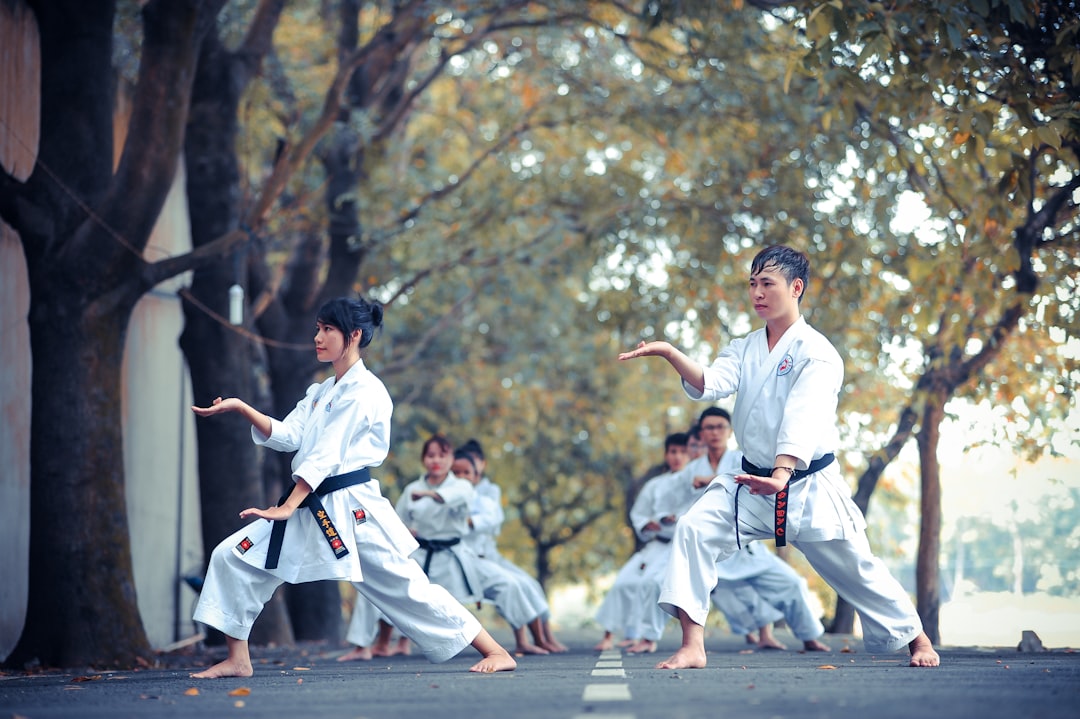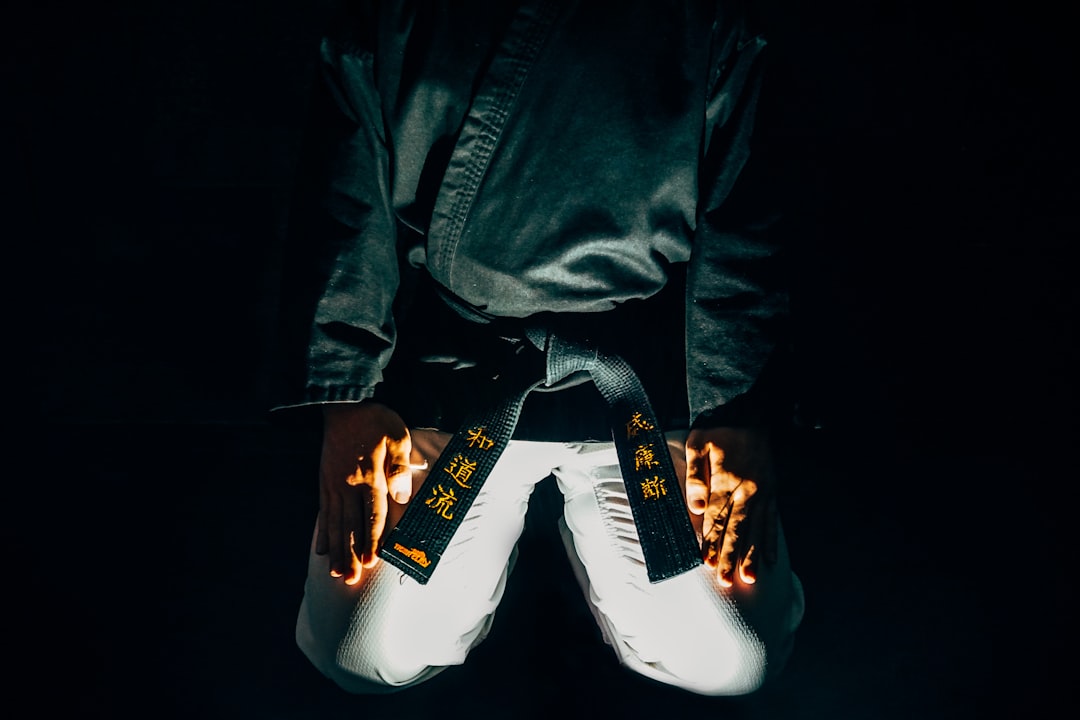Training karate at home effectively requires not only dedication to the discipline but also the proper attire—a karate gi. This traditional garment is integral for both respecting karate's heritage and ensuring optimal performance during practice. The ideal home training gi should be crafted from durable, breathable materials like cotton or hemp, allowing for full range of motion without restriction. It should fit snugly to facilitate learning techniques effectively. Color variations in the gi can signify one's rank within the karate community, with white often symbolizing a beginner's journey. Selecting the right type of gi is crucial for home training as it embodies the essence of the art, fosters discipline, and honors karate's rich traditions. Additionally, proper maintenance of the gi after intense training sessions is essential to extend its lifespan and preserve its quality, involving immediate post-training care, cold water treatment for stains, and gentle washing and drying methods to avoid damage and fading. This upkeep not only maintains the gi's fit and appearance but also reflects respect for the discipline. For those training karate at home, the choice of attire is a significant factor that influences both cultural tradition and performance, making the karate gi a key element in creating a disciplined and effective training environment.
Embarking on a journey to master karate from the comfort of your own home requires dedication and the right equipment. Among these essentials is the karate uniform, commonly known as a Gi. This article delves into the significance of the Gi in your training regimen, offering insights into its composition, design, and fit to enhance your practice sessions. We’ll guide you through selecting the ideal Gi for home training, ensuring it meets the standards for effectiveness and comfort. Additionally, we provide maintenance tips to keep your Gi in top condition. Understanding how a proper Karate uniform contributes to mastering techniques in your personal space is crucial for anyone serious about their martial arts practice.
- Understanding the Essentials of Karate Training at Home: The Significance of Your Uniform
- The Anatomy of a Karate Gi: Material, Design, and Fit for Effective Practice
- Step-by-Step Guide to Selecting the Perfect Karate Uniform for Home Training
- Tips for Maintaining and Caring for Your Karate Gi Post-Training Sessions
- Mastering Karate Techniques in Your Own Space: The Role of Proper Attire in Your Practice Routine
Understanding the Essentials of Karate Training at Home: The Significance of Your Uniform

Engaging in karate training at home necessitates a deep understanding of the discipline, which includes recognizing the importance of your uniform, often referred to as a gi. The gi is not merely a garment; it represents respect for tradition and readiness for practice. When training karate from the comfort of your own space, having the proper attire can reinforce the sense of formality and focus that underpins effective training. Is the karate gi you wear just a piece of clothing or does it hold deeper significance? The gi’s role is multifaceted: it provides a uniform foundation for learning techniques properly, allows for a range of motion necessary for practicing moves, and signifies your commitment to the art of karate. It also differentiates you from other martial arts, setting karate apart as its own discipline with specific protocols and traditions. Is there a right type of gi for home training? Absolutely, the ideal gi for home practice should be comfortable, made of cotton or hemp for durability and breathability, and fit well to avoid any hindrance during exercises. The choice of color can also signify your rank or status within the karate community, with white often representing a beginner’s humility and other colors denoting higher levels of mastery. Understanding the significance of your uniform contributes to a more profound respect for the practice and prepares you mentally and physically for disciplined karate training at home.
The Anatomy of a Karate Gi: Material, Design, and Fit for Effective Practice

When practicing karate at home or in a dojo, the attire one wears is not just a matter of tradition but also impacts performance and comfort. A karate gi, commonly referred to as a ‘keikogi,’ serves as the quintessential training uniform for martial artists. Comprised primarily of cotton or hemp fabric, which allows for breathability and ease of movement, the keikogi is designed with specific features that cater to the needs of karateka during training. The jacket, known as the ‘uedemi,’ features a belt loop at the waist, allowing it to be secured with an obi, or belt, signifying the wearer’s rank. The trousers, called ‘rekōgatari,’ are straight-legged and reach just above the ankle, ensuring they do not impede movement while providing adequate coverage.
The fit of a karate gi is crucial for effective practice; it should not be too tight or too loose. A well-fitted gi allows for a full range of motion, enabling practitioners to execute techniques with precision and control. The length of the sleeves and the hem of the trousers should reach just past the hands and ankles respectively, maintaining a clean and neat appearance that is conducive to the discipline inherent in karate training. When training karate at home, it’s important to choose a gi made from quality material that will withstand repeated washes without losing its shape or becoming see-through. Does the keikogi you have provide the necessary durability and mobility for your practice? It should not only be durable but also conform to your body without being restrictive, ensuring that each movement is both effective and true to form.
Step-by-Step Guide to Selecting the Perfect Karate Uniform for Home Training

When training karate at home, selecting the appropriate uniform is crucial to ensure comfort, mobility, and adherence to traditional practices. The karate uniform, known as a gi, is a key component of the martial art’s discipline and tradition. To begin with, consider the material of the gi. A high-quality cotton or a blend that allows for easy movement while providing durability is ideal. Does the fabric feel comfortable against your skin? Will it hold up to repeated washes and wear? The jacket should fit properly; it’s not too tight or too loose. For children especially, a well-fitted gi can make a significant difference in their ability to perform techniques correctly. How does the jacket sit on your child’s shoulders and torso? Is there sufficient room for them to move their arms freely without restriction?
Next, focus on the pants, or trousers, of the gi. They should be snug but not overly tight around the waist and legs. Can you comfortably crouch, squat, or assume other karate stances without feeling constricted? The trousers’ length is also important; they should stay in place during practice. Is there a drawstring to secure them during dynamic movements? Additionally, consider the color and style. Traditionally, karate gi are white with a black belt, but some styles or personal preferences may vary. What color and style best align with your training needs and preferences? Remember, consistency in appearance can reinforce the discipline and respect inherent to the practice of karate. Ensure that the uniform you choose complies with any specific guidelines provided by your sensei or the particular style of karate you are practicing. By carefully selecting each aspect of your karate gi, you will be well-equipped for effective train karate home sessions.
Tips for Maintaining and Caring for Your Karate Gi Post-Training Sessions

When it comes to maintaining your karate gi after a rigorous training session, proper care extends the life of your uniform and maintains its integrity. To begin with, always remember to remove your gi promptly after training to prevent bacteria from settling in the fabric, especially if you train at home or in shared spaces. Once removed, address any stains immediately; cold water is your ally here as it helps to rinse away perspiration and any residual odors that can cling to the cotton material.
For a more thorough cleaning, wash your gi separately in a washing machine using a mild detergent, which is gentle on the natural fibers. Avoid using fabric softeners or bleach, as these can weaken the fabric and reduce the durability of the gi. After washing, hang the gi to dry flat in a well-ventilated area out of direct sunlight, which can cause fading. Ironing on the lowest heat setting is recommended for wrinkle removal, ensuring that the iron does not come into contact with the gi directly to prevent scorching or damage to the material. Proper care of your karate gi is essential for maintaining its functionality and respect for the discipline, especially when training karate at home. Regularly inspecting and treating any shrinkage or wear can help maintain the fit and appearance of your uniform, ensuring you’re always prepared for your next training session.
Mastering Karate Techniques in Your Own Space: The Role of Proper Attire in Your Practice Routine

Engaging in Karate training at home requires dedication, discipline, and the right environment to practice effectively. When considering how to train karate home, one must not overlook the significance of donning the appropriate attire, commonly known as a Gi. This traditional garment is not merely a uniform but a symbol of respect for the martial art. The Gi facilitates proper technique execution by providing a consistent and comfortable layer that allows for unrestricted movement during practice. Is the Gi essential for training at home? Absolutely; it’s designed to move with your body, ensuring no distractions as you execute techniques such as kicks, blocks, and strikes. The fabric of the Gi also helps in understanding the dynamics of one’s movements as it provides a tactile reference point against an opponent’s or partner’s garment during practice, which is crucial for learning and refining skills.
In addition to its practical benefits, wearing a Gi while training karate at home instills a sense of discipline and tradition that aligns with the martial art’s ethos. It serves as a daily reminder that you are part of a legacy of practitioners who have honed their skills within this garment. Can the right attire influence your mindset and performance during training sessions? Yes, it can. The Gi is a tangible link to the practice and philosophy of Karate, and when you step into your training space adorned in this uniform, you signal to yourself and anyone watching that you are there to train with seriousness and respect for the art. Whether you’re a beginner or an advanced practitioner, the Gi is an integral part of your home training regimen, helping you to master Karate techniques in your own space with the appropriate mindset and physical preparation.
When practicing karate at home, adherence to tradition and functionality is key, particularly in selecting the appropriate attire. A Karate Gi serves as more than a uniform; it’s an integral part of the discipline, facilitating movement and emphasizing the martial artist’s commitment. This article has outlined the essential aspects to consider when acquiring your Gi, ensuring it meets both the standards of traditional practice and your personal training needs. By understanding the significance of your uniform and how to care for it, you can fully immerse yourself in mastering karate techniques within your own space. Remember to choose a Gi that aligns with the principles of effective home training, and maintain it properly to uphold the dignity and discipline inherent in this martial art form. Whether you’re a beginner or an advanced practitioner, the right Karate Gi is essential for both performance and respect for the art.
